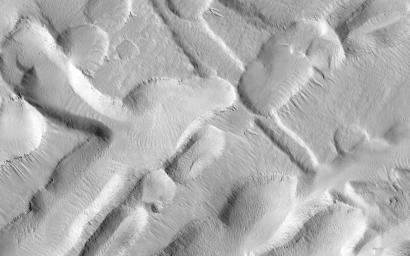
|
The Busy Flank of Arsia Mons
- Click the image above for a larger view
- Full-Res JPEG (2880 x 1800) (682.4 kB)
- Full-Res TIFF (2880 x 1800) (5.2 MB)
Caption:

Map Projected Browse Image
Click on the image for larger version
This observation shows an incredible diversity of ancient lava tubes and impact craters filled with sediment on the flank of Arsia Mons.
The rationale for this observation is to get a better look at those lava tubes; their shapes, morphology, and erosional degradation, which ultimately might help to date active period when lava flowed through the volcano. We will also be able to see in high resolution an erosional "snapshot" of the collapsed lava tubes and how they have been modified by dust falling from the air, mass-wasting, and impacts over time.
Background Info:
HiRISE is one of six instruments on NASA's Mars Reconnaissance Orbiter. The University of Arizona, Tucson, operates HiRISE, which was built by Ball Aerospace & Technologies Corp., Boulder, Colorado. NASA's Jet Propulsion Laboratory, a division of the California Institute of Technology in Pasadena, manages the Mars Reconnaissance Orbiter Project for NASA's Science Mission Directorate, Washington.
Cataloging Keywords:
| Name | Value | Additional Values |
|---|---|---|
| Target | Mars | |
| System | ||
| Target Type | Planet | |
| Mission | Mars Reconnaissance Orbiter (MRO) | |
| Instrument Host | Mars Reconnaissance Orbiter | |
| Host Type | Orbiter | |
| Instrument | High Resolution Imaging Science Experiment (HiRISE) | |
| Detector | ||
| Extra Keywords | Crater, Dust, Grayscale, Impact, Map, Mountain, Volcano | |
| Acquisition Date | ||
| Release Date | 2014-05-22 | |
| Date in Caption | ||
| Image Credit | NASA/JPL-Caltech/Univ. of Arizona | |
| Source | photojournal.jpl.nasa.gov/catalog/PIA18649 | |
| Identifier | PIA18649 | |
